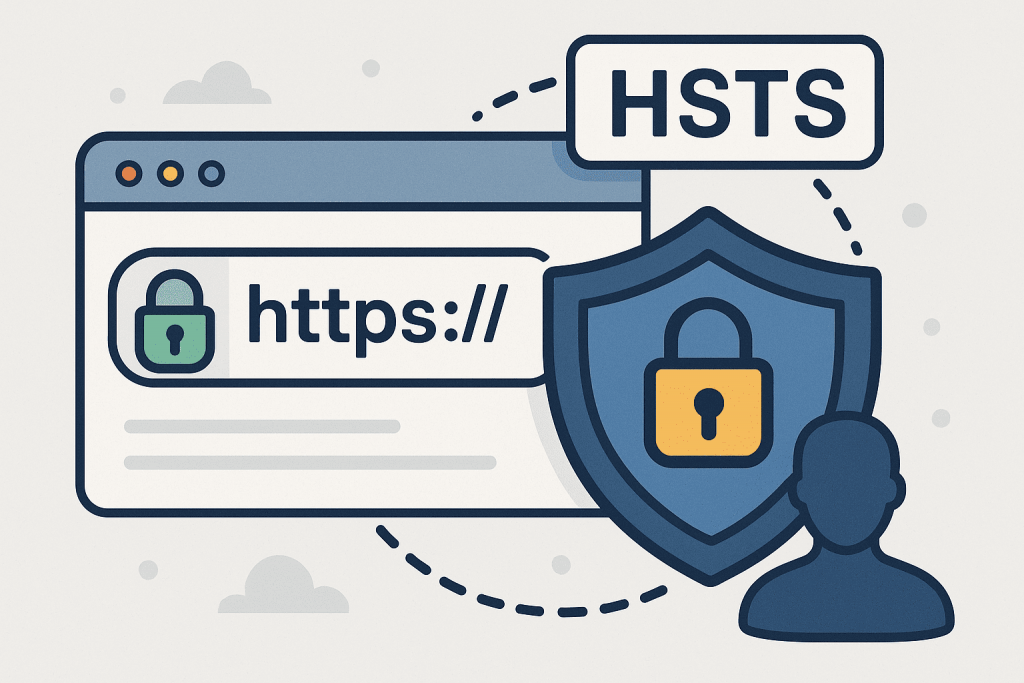
In today’s world, where online security is as essential as a lock on your front door, the HSTS protocol works quietly yet effectively. Every day, millions of people open websites, enter passwords, make purchases, or conduct online banking — often unaware that a hacker could intercept their connection. While an SSL certificate encrypts communication, HSTS ensures that users never connect to a site without HTTPS. It’s as if the browser receives a strict order: “Use HTTPS only — no exceptions.”
How HSTS Works
HSTS stands for HTTP Strict Transport Security. This technology was developed to prevent attackers from downgrading connections from HTTPS to unencrypted HTTP. When a website is properly configured, it sends the browser a special header — Strict-Transport-Security. This header tells the browser: “Remember — this site must always use HTTPS.” Once the browser receives it, it stores the rule and automatically enforces it on all future visits, even if the user types the address without “https://”.
For example, if someone types example.com, the browser won’t even try to connect over HTTP — it will instantly switch to https://example.com. In this way, HSTS eliminates the vulnerable moment when a hacker could inject malicious code or hijack the session between client and server.
Why HSTS Became a Security Standard
Internet security has always relied on multiple layers. HTTPS encrypts the data, SSL certificates verify authenticity, and HSTS adds another safeguard — it guarantees that the user always connects securely. Major browsers like Chrome, Firefox, Safari, and Edge have adopted it, and most major websites — including Google, Facebook, and Amazon — use it by default.
The advantage of HSTS is its simplicity for users. After the first visit, the browser automatically remembers the instruction and enforces it silently. Even users who have no technical knowledge stay protected — the system works behind the scenes.
Threats HSTS Prevents
One of the most common attacks that HSTS blocks is the SSL-strip technique. In such an attack, a hacker intercepts traffic and forces the user to connect via HTTP, even though the site supports HTTPS. This exposes sensitive information like passwords or payment data in plain text. When HSTS is enabled, such an attack becomes impossible — the browser refuses to establish an insecure connection.
HSTS also protects against accidental errors — for instance, when a user visits an outdated HTTP version of a site or when hackers try to spoof a Wi-Fi network. It acts as a digital guard, blocking any unencrypted requests before they can cause harm.
What Is HSTS Preload and Why It Matters
Another key feature is the HSTS Preload list — a database of domains hardcoded into browsers that must always use HTTPS. When a user visits one of these sites, the browser immediately establishes a secure connection without even attempting HTTP. This removes any potential vulnerability during the first connection.
To be added to the Preload list, a site owner must correctly configure HSTS headers and submit the domain at preload.hstspreload.org. Browser vendors update this list regularly, ensuring users are protected before they ever visit the website.
How HSTS Improves User Experience
At first glance, HSTS may seem like a purely technical feature invisible to users. In reality, it makes browsing safer and smoother. No more “Not Secure” warnings, fewer redirections, and faster page loads since the browser goes straight to HTTPS.
For businesses, this translates into stability and customer trust. When visitors see that their data is always secure, they’re more likely to interact, make purchases, and stay loyal. That’s why HSTS has become a core element of every serious cybersecurity strategy.
Why You Should Enable HSTS on Your Website
As cyber threats evolve, relying solely on an SSL certificate is no longer enough. HSTS strengthens your site’s protection with minimal effort — no extra tools, no added cost. Enabling it takes only a few minutes but provides ongoing defense against data interception and spoofed connections.
If your website already supports HTTPS, add the Strict-Transport-Security header and test it carefully. This simple step contributes to a safer internet — one where users’ data stays private and protected.
HSTS isn’t just a technical feature — it’s a mark of responsibility. It shows that the website owner values security, respects user trust, and ensures that every connection remains encrypted and safe.

Leave a Reply